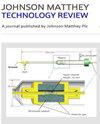Impact of Solution Chemistry on the Biotechnological Synthesis and Properties of Palladium Nanoparticles
IF 2
4区 化学
Q4 CHEMISTRY, PHYSICAL
引用次数: 0
Abstract
The biosynthesis of Pd nanoparticles supported on microbial cells (bio-Pd) has attracted much recent interest, but the effect of solution chemistry on the process remains poorly understood. Biological buffers can be used to maintain physiological pH during the bioreduction of Pd(II) to Pd(0) by microbial cells, however, buffer components have the potential to complex Pd(II), and this may affect the subsequent microbe-metal interaction. In this study, a range of Pd(II) salts and biological buffers were selected to assess the impact of the solution chemistry on the rate of bioreduction of Pd(II) by Geobacter sulfurreducens, and the resulting biogenic Pd nanoparticles. The different buffer and Pd(II) combinations resulted in changes in the dominant Pd(II) species in solution, and this affected the amount of Pd recovered from solution by the microbial cells. The physical properties of the bio-Pd nanoparticles were altered under different solution chemistries; only slight variations were observed in the mean particle size (< 6 nm), but significant variations in particle agglomeration, the extent of Pd(II) bioreduction, and subsequent catalytic activity for the reduction of 4-nitrophenol were observed. The combination of sodium tetrachloropalladate and bicarbonate buffer resulted in bio-Pd with the smallest mean particle size, and the fastest initial rate of reaction for 4-NP reduction (0.33 min-1). Other solution chemistries appeared to damage the cells and result in bio-Pd with relatively poor catalytic performance. This work emphasises that future studies into bio-Pd synthesis should consider the importance of solution chemistry in controlling the speciation of Pd(II) and its impact on both the bioreduction process and the resulting properties of the nanoparticles produced, in order to maximize Pd(II) biorecovery and optimize catalytic properties.溶液化学对钯纳米颗粒生物技术合成及性能的影响
微生物细胞支持的钯纳米颗粒的生物合成引起了人们的广泛关注,但溶液化学对这一过程的影响仍然知之甚少。在微生物细胞将Pd(II)生物还原为Pd(0)的过程中,生物缓冲液可用于维持生理pH值,然而,缓冲液成分有可能使Pd(II)复杂化,这可能会影响随后的微生物-金属相互作用。在这项研究中,选择了一系列Pd(II)盐和生物缓冲液来评估溶液化学对硫还原地球杆菌生物还原Pd(II)速率的影响,以及由此产生的生物源Pd纳米颗粒。不同的缓冲液和Pd(II)组合导致溶液中Pd(II)优势种的变化,从而影响微生物细胞从溶液中回收Pd的量。在不同的溶液化学条件下,生物钯纳米粒子的物理性质发生了变化;平均粒径(< 6 nm)变化不大,但颗粒团聚、Pd(II)生物还原程度以及随后对4-硝基苯酚还原的催化活性变化显著。四氯alladate钠和碳酸氢盐缓冲液的组合使bio-Pd具有最小的平均粒径和最快的4-NP还原初始反应速率(0.33 min-1)。其他溶液化学物质似乎会损害细胞,导致催化性能相对较差的生物钯。这项工作强调,未来的生物Pd合成研究应考虑溶液化学在控制Pd(II)形态及其对生物还原过程和所产生纳米颗粒性能的影响方面的重要性,以最大限度地提高Pd(II)的生物回收率和优化催化性能。
本文章由计算机程序翻译,如有差异,请以英文原文为准。
求助全文
约1分钟内获得全文
求助全文
来源期刊

Johnson Matthey Technology Review
CHEMISTRY, PHYSICAL-
CiteScore
4.30
自引率
4.30%
发文量
48
审稿时长
12 weeks
期刊介绍:
Johnson Matthey Technology Review publishes articles, reviews and short reports on science enabling cleaner air, good health and efficient use of natural resources. Areas of application and fundamental science will be considered in the fields of:Advanced materials[...]Catalysis[...][...]Characterisation[...]Electrochemistry[...]Emissions control[...]Fine and speciality chemicals[...]Historical[...]Industrial processes[...]Materials and metallurgy[...]Modelling[...]PGM and specialist metallurgy[...]Pharmaceutical and medical science[...]Surface chemistry and coatings[...]Sustainable technologies.
 求助内容:
求助内容: 应助结果提醒方式:
应助结果提醒方式:


